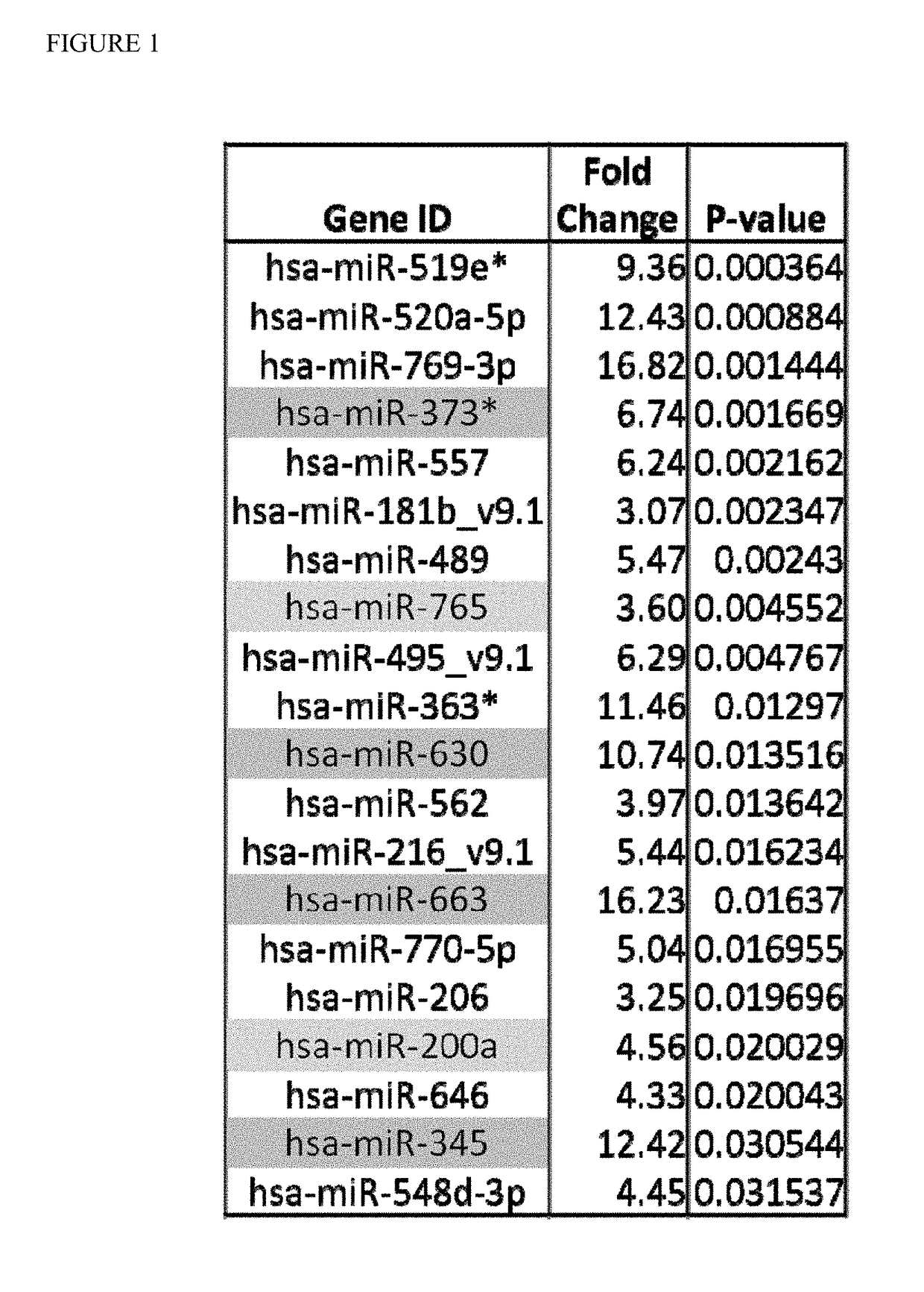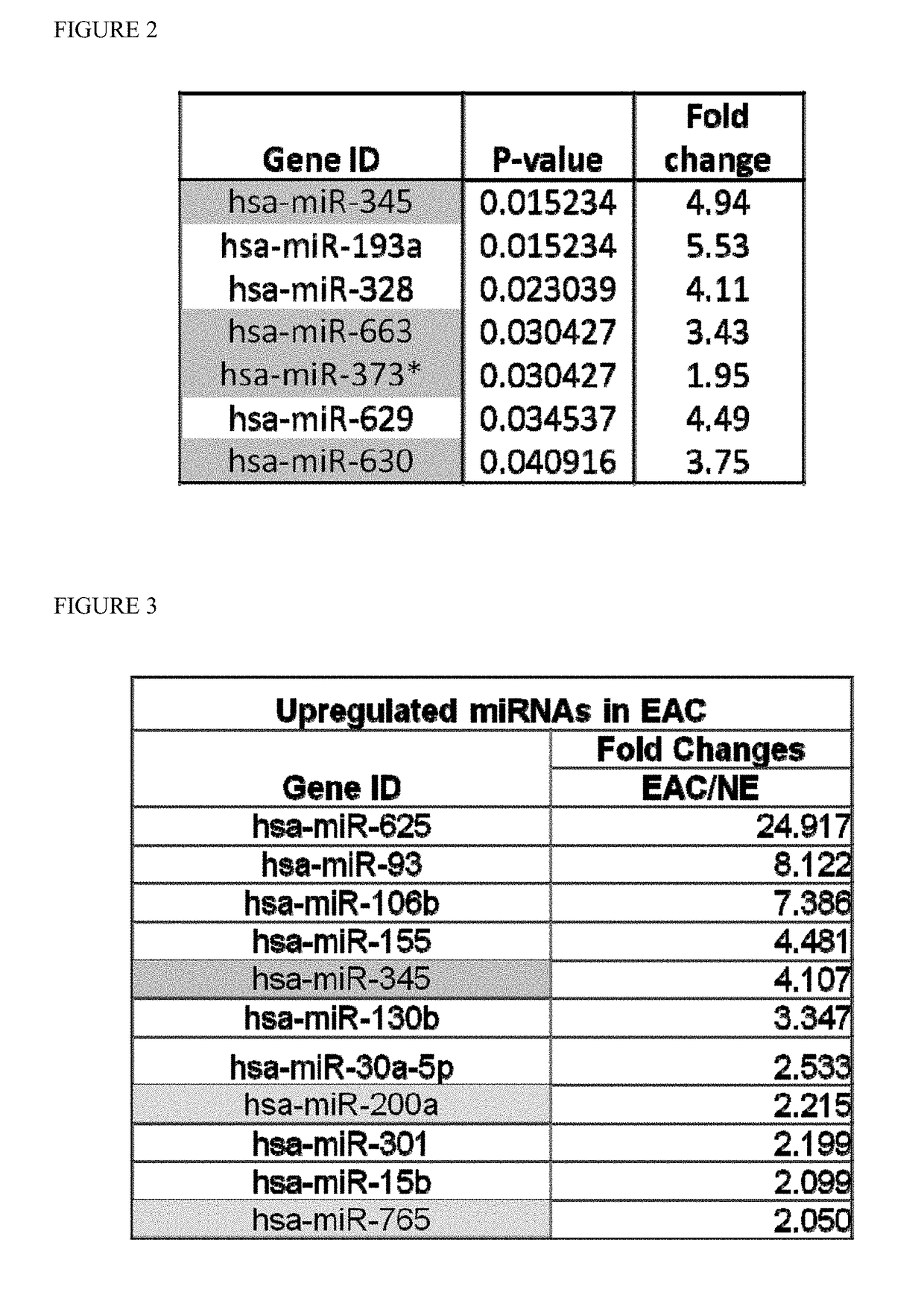Serum-based mirna microarray and its use in diagnosis and treatment of barrett's esophagus (BE) and esophageal adenocarcinoma (EAC)
a technology of serum-based mirna and microarray, which is applied in the direction of microbiological testing/measurement, biochemistry apparatus and processes, etc., can solve the problems of unsuitable endoscopic surveillance for most patients presenting with eac, unsuitable serum-based screening or detection, and inability to detect
- Summary
- Abstract
- Description
- Claims
- Application Information
AI Technical Summary
Benefits of technology
Problems solved by technology
Method used
Image
Examples
example 1
[0079]MiR microarrays are hybridized to miRs extracted from matching tissues and blood obtained from 16 subjects each with esophageal adenocarcinoma (EAC), and compared to that of 12 healthy subjects.
[0080]In addition to these samples, miRs extracted from various normal esophageal, Barrett's, and EAC cell lines (HEEPiC, CHTRT, GiHTRT, QHTRT, and OE33 from ATCC, Manassas, Va.) were also used. For these experiments, we used QIAGEN's miRNeasy Mini Kit for the actual miR extraction, and Agilent's Human miRNA Microarray V1 which contains 471 human miRs.
example 2
[0081]MiR-array data generated was normalized either by Agilent's GeneSpring GX 11.5 software or by the array control small RNA called Hurs. The normalized data was analyzed using significance analysis of microarrays (SAM).
[0082]The serum data was first normalized using the Hurs array control (FIG. 1). The top 144 highest fold-change overexpressed miRs were selected that differed by a significant p-value between diseased and normal control (NC). As a final filtering criterion, to ensure that serum miRs will be robustly detectable, miRs were chosen whose individual serum levels uniformly exceeded array background by at least a factor of 5.
[0083]Next, the same data was normalized using GeneSpring GX 11.5 software, which used percentile shift normalization. This procedure generated an initial 7 possible miR candidates (FIG. 2).
example 3
[0084]The cell line data from various normal esophageal, Barrett's, and EAC cell lines (HEEPiC, CHTRT, GiHTRT, QHTRT, and 0E33) was processed in the same way as the serum data in Example 2. The cell line data SAM result generated 11 possible miR candidates (FIG. 3). We arrived at a selection of 14 miR candidates (hsa-miR-200a, hsa-miR-345, hsa-miR-373*, hsa-miR-630, hsa-miR-663, hsa-miR-765, hsa-miR-625, hsa-miR-93, hsa-miR-106b, hsa-miR-155, hsa-miR-130b, hsa-miR-30a, hsa-miR-301a, hsa-miR-15b) which commonly appeared or significant in 3 separate analysis.
[0085]All references, including publications, patent applications, and patents, cited herein are hereby incorporated by reference to the same extent as if each reference were individually and specifically indicated to be incorporated by reference and were set forth in its entirety herein.
[0086]The use of the terms “a” and “an” and “the” and similar referents in the context of describing the invention (especially in the context of ...
PUM
| Property | Measurement | Unit |
|---|---|---|
| temperatures | aaaaa | aaaaa |
| size | aaaaa | aaaaa |
| biological stability | aaaaa | aaaaa |
Abstract
Description
Claims
Application Information
 Login to View More
Login to View More - R&D
- Intellectual Property
- Life Sciences
- Materials
- Tech Scout
- Unparalleled Data Quality
- Higher Quality Content
- 60% Fewer Hallucinations
Browse by: Latest US Patents, China's latest patents, Technical Efficacy Thesaurus, Application Domain, Technology Topic, Popular Technical Reports.
© 2025 PatSnap. All rights reserved.Legal|Privacy policy|Modern Slavery Act Transparency Statement|Sitemap|About US| Contact US: help@patsnap.com


